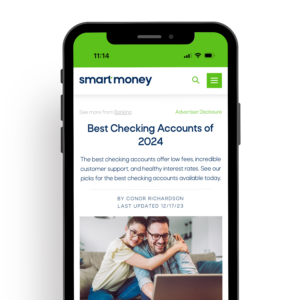Takeaways
- 457(b) plans allow you to contribute pre-taxed dollars, which decreases your taxes.
- 457(b) plans are grouped into either government or non-government plans.
- 457(b) plans let your contributions grow tax-free until your withdrawal funds.
- 457(b) plans have annual contribution limits set by the IRS annually.
- 457(b) plans are like 401(k) and 403(b) plans but have unique features.
Some of the links in this article are from advertising partners of Smart Money, which does not influence our evaluations or recommendations. We work to provide you with accurate and reliable information. Our opinions are our own.
Saving for retirement can be daunting. With so many retirement accounts, plans, and investments to consider, it can be easy to feel a little overwhelmed. However, picking the right investment strategy and retirement account can set you up for a lifetime of financial success.
Any retirement plan should be considered in the context of your financial goals and broader financial planning efforts. One plan to consider is the 457(b) plan, which some employers offer and can help supercharge your retirement savings.
What is a 457(b) Plan?
A 457(b) is a specific type of deferred compensation tax-advantaged retirement plan designed for public sector employees to save for retirement. You might be eligible for a 457(b) plan if you work for a state or local government agency or eligible non-profit organization.
457(b) plans work similarly to a 401(k) plan in that you contribute pre-taxed income into your account. You can make these contributions per paycheck or in lump sums over time. Your contributions grow tax-free and are only taxed upon withdrawal from the account. This means your investments can accumulate with capital appreciation, dividend reinvestment programs, or fixed-income investments.
If you work as a police officer, firefighter, or school nurse, you can elect for part of your paycheck to flow into your 457(b) plan. Pre-tax contributions help you save for retirement and when you file taxes by reducing your taxable income.
A 457(b) could be your ticket to tax-advantaged retirement savings. Let’s look at the ins and outs of how a 457(b) plan works.
How 457(b) Plans Work
457(b) plan contributions work similarly to other retirement savings accounts, like 403(b) or 401(k) plans. Making paycheck contributions means you defer income to your retirement savings before taxes.
There are two immense benefits right off the bat. First, you are saving and investing more (since your contributions are pre-tax). Second, reducing your taxable income may bump you into a lower tax bracket and leave you paying less total tax.
Read More -> 2023-2024 Income Tax Rates and Brackets
Once you contribute to your 457(b), you can choose how to invest the funds. The main goal is to grow your savings over time so that you have money waiting for you during retirement. Once you have made some contributions, the most important thing to remember is that stock markets like the NASDAQ or NYSE will have ups and downs, just like the general economy. No matter how conservative your investments are, there will always be investment risk. Your investment risk should align with your investment time horizon and overall portfolio strategy.
You are wondering when you will be able to access your funds. In most cases, you can withdraw from your 457(b) plan once you officially retire or after severance from your employment. The most distinct benefit of a 457(b) plan may be the lack of an early withdrawal penalty under the right circumstances. Unlike other retirement accounts, if you have left your job, you can take out your funds without an early withdrawal penalty, regardless of age.
With a 457(b) plan, your employer may also make matching contributions to your plan. The funds you contribute vest immediately, and the contributions from your employer will vest over time according to your specific 457(b) plan documents. Vesting can occur immediately or over a set time.
You can keep the momentum from your retirement savings plan going because the 457(b) plan allows rollovers to other eligible retirement plans. In fact, transfers from one state or local government 457(b) can be made to another 457(b) plan. This is a great feature that gives you the ability to save uninterrupted for retirement.
Read More -> 5 Amazing Smart Money Savings Habits to Start Now
Get Smart With Your Money
Fresh weekly articles delivered straight to your inbox.
Enter your name and email for free tips and tricks.

What Can You Invest in with a 457(b)?
Like other government retirement accounts, there are restrictions with the 457(b) plan. Unlike Traditional IRA or Roth IRA, where you can invest in stocks, bonds, ETFs, target-date funds, and mutual funds, 457(b) plans offer a much more curated list of investments.
457(b) plans typically only offer investments in two investments: mutual funds and annuities [1].
- Mutual Funds are pools of capital managed by a fund manager who invests their capital based on specific investment strategies. Investors buy shares in a mutual fund at the end of the trading day based on the fund’s Net Asset Value.
- Annuities are contracts between individuals and insurance companies that help investors secure a reliable income in the future.
Even with a more restricted set of investment options, 457(b) plans can accumulate serious savings. With time, compounding interest, and steady market returns, you can turn regular contributions into a sizable retirement account.

Acorns Website
Acorns Investing App
Intro Offer: $20 Bonus Investment
Recommended For: Beginner Investors
Annual Fee: N/A
Smart Money Rating: 5/5
Contribution Limits for 2024
407(b) plans offer tremendous retirement savings benefits to employees. Because of this, the Internal Revenue Service (IRS) sets contribution caps and limits, which can change annually.
For 2024, the 457(b) contribution limit, or the total amount that you can contribute before taxes, is $23,000 [2]. Based on your financial situation, you must decide if maxing out your contributions will accelerate your path to your goals.
If you are 50 years old or older and have not been saving as much as you would have liked, there is good news. The IRS will let you make “catch-up” contributions in addition to the standard contribution limit. For 2024, the catch-up contribution limit is an additional $7,500. This means that if you are 50 or over, the maximum contribution is $30,500 for 2024.
These individual contribution limits do not include employer contributions, often called matching contributions. If you have not heard of this type of program before, you are in for a treat. As an added employee benefit, some employers offer a matching contribution program which can augment your savings substantially. Essentially, your employer “matches” the funds that you contribute. These matched funds can be a percentage of your contributions, a fixed amount, or other structure.
Having a clear understanding of the contribution limits and unique matching contribution programs available to you is vital for your retirement planning. These elements will allow you to map out how much you need to save each year. Not sure where you stand among your peers? Read more about the average 401(k) saving balance by age, which might serve as a savings proxy.
What is a 457(b) Catch-Up Deferral?
In the final years before you retire, many savers feel they need to boost retirement savings even more. If you fall into this camp, the 457(b) catch-up deferral can be extremely beneficial. A unique 457(b) rule enables you to save even more than the standard contribution limit in the final years before retirement.
If you are within three years of your plan’s standard retirement age (and your plan permits it) and have not contributed the maximum allowed in previous years, you may be able to use this catch-up. You can double your contributions instead of using the usual 50-years-old or older catch-up contribution limit. Here is how it works:
Special 457(b) catch-up contributions are limited to the lower of:
- $46,000 (twice the basic annual Limit in 2023)
- The Basic annual limit plus unused basic annual limit in prior years (you are only allowed to use this if you are not using the age 50 or over catch-up).
That said, there are things to keep in mind. First (and perhaps most noteworthy), you will not be able to use the 50 and over catch-up and the 457(b) special catch-up in the same year [3]. Secondly, to qualify for the special catch-up, you must prove you have not maxed out your contributions in previous years.
457(b) vs. 401(k)
Compared to a 457(b) plan, a 401(k) plan is far more common and well-known. Both are vital vehicles for retirement savings but have significant differences. Here are two critical differences to know:
- Who Offers Plans: First, the type of employers that offer these plans is a differentiator. 457(b) plans are offered by state and local government entities and some non-profits, while 401(k) plans are provided by companies in the private sector, including both publicly traded companies (e.g., on the NASDAQ or NYSE) and private companies.
- Withdrawals: Another noteworthy difference is the withdrawal rules. With a 457(b) plan, you can take early distributions from a 457(b) if you leave your job, no matter your age. Although withdrawals will be taxed as ordinary income, the benefit is that you can easily access these funds. 401(k) plans are more restrictive about when you can dip into your savings. With a 401(k) plan, in most cases, withdrawals before age 59 ½ incur a 10% penalty.
457(b) vs. 403(b)
There are many similarities between a 457(b) plan to a 403(b) plan. For instance, both plans are for public sector employee school employees. Here are two critical differences between the plan offerings:
- Catch-Up Contributions: The 457(b) offers a three-year catch-up deferral that could double contributions. The 403(b) allows a different type of catch-up for those with 15 years of employment with the same employer that could add up to $15,000 in additional contributions for the lifetime of the account.
- Withdrawals: The 457(b) also offers penalty-free withdrawals if you leave the employer. Increased access to funds makes your 457(b) contributions much more liquid and accessible for you to retire early. The 403(b) plan does not offer this, just like the 401(k) does not allow you to dip into your savings without penalty until you are 59 and a half years old.
Smart Summary
Saving for retirement takes thoughtful consideration. Tax-deferred retirement savings programs like the 457(b) offer you the advantage of stashing away salary reduction contributions to investments like mutual funds and annuities. Additionally, your government agency or non-profit organization might make matching contributions to fuel your retirement savings and net worth. Taking advantage of these programs is a smart money move, especially when they align with your long-term financial goals.
Frequently Asked Questions
Many plans permit loans and distributions for unforeseen emergencies. Consider building an emergency fund or slush fund so you do not need to tap into your retirement savings.
Any tax-exempt organization that is not a church can offer a 457(p) plan. Depending on your employers, you can also investigate 403 plans or 401(k) plans.
One of the main advantages of the 457(b) plan is that it may include a Roth program. However, you should check with your employer to see if your plan gives this option. Read more about Roth IRAs.
Sources
(1) Internal Revenue Service. 403(b) and 457(b) Plans. Last Accessed April 2, 2024.
(2) Internal Revenue Service. 401(k) limit increase to $23,000 for 2024, IRA limit rises to $7,000. Last Accessed April 2, 2024.
(3) Internal Revenue Service. Plan Feature Comparison Chart. Last Accessed April 2, 2024.
https://www.fidelity.com/learning-center/smart-money/what-is-a-457b










